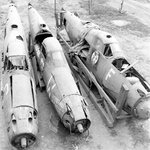Greg Boeser
1st Lieutenant
Actually, they are. As of 1 April 1942, the fighter unit of the 4th AG, originally made up of pilots and aircraft of the Chitose AG from the Marshalls, and the Kawai Buntai from Palua (itself made up of pilots from Tainan and 3rd AGs), was amalgamated into the Tainan AG, the main body of which did not arrive at Rabaul until mid-April aboard Komaki Maru. The 4th AG fighter unit was originally equipped with A5Ms but these were kept at Rabaul and steadily augmented by Zeroes. By 28 April the Tainan had 24 Zeroes at Lea and eight more at Rabaul, along with six A5Ms. The A5Ms, while scoring some early successes against RAAF Catalinas and Hudsons, were no match for B-17s and B-26s and were withdrawn from front line duties during May.Not all the claims are against Tainan.
Nishizawa was part of the 4th AG and scored several kills in A5Ms before the arrival of the Zeroes.
Of note is that no Tainan pilots were lost defending Rabaul, despite numerous claims by bomber gunners.
Between April and November in operations over New Guinea, Rabaul and Northern Australia, 81 Allied aircraft shot down can be directly attributed to Tainan pilots - 17 Kittyhawks/Warhawks, 38 P-39/P-400s, five A-24s, one Hudson, 10 B-25s, 5 B-26s, 5 B-17s.
So, according to Ruffato's analysis the Tainan had roughly a 4:1 advantage over the P-39/P-400 in 1942, 3:1 over P-40s. 5:1 vs allied medium and light bombers, and 5:3 vs B-17s.
Clearly the way to defeat the Zero is with more B-17s.
Significantly, many allied flyers shot down lived to fight another day, whereas the Tainan pilots, eschewing parachutes and radios, ended up dead or captured.
Last edited:


